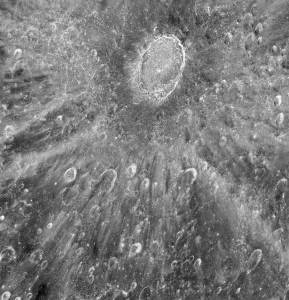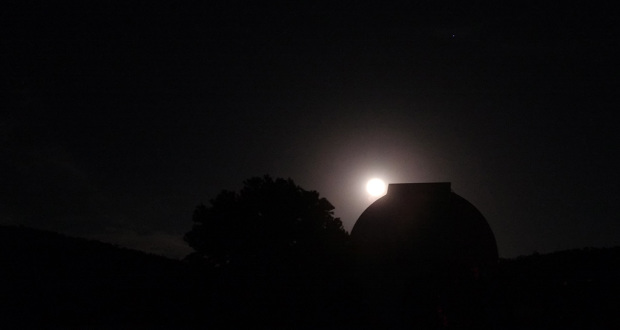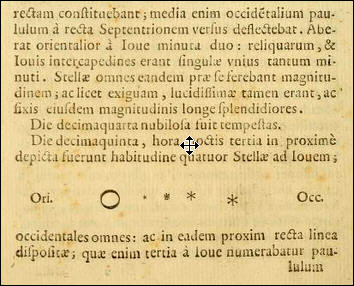Not surprisingly, somebody thought this would be a good place to put a telescope.
The McDonald Observatory, which opened in 1939, is perched atop Mount Locke and Mount Fowlkes, about a half-hour drive from Davis Mountains State Park. Its original 82-inch telescope was the second-largest in the world at the time. Another of 107 inches was added in 1968, and in 1997 the observatory installed the Hobby-Eberly Telescope whose 91 individual mirror segments are the equivalent of whopping 9.2 meters.
There are myriad opportunities to peer through the observatory’s powerful glass. At weekly star parties, weather permitting, you get an under-the-sky tour of the constellations in the observatory’s outdoor amphitheater and access to a half dozen telescopes of various sizes – including a couple at 22 inches.
Less frequent and more expensive viewing is available on the larger scopes with dinner programs and lectures. There, the programs have to jockey for time with the astronomers who make a living on the same telescopes.
I visited the observatory on a cold, clear night in April. The telescopes were pointed at Jupiter and its four Galilean moons, Mars, the Moon, the Orion Nebula and the Beehive Cluster.
With the proliferation of deep space images from the Hubble Space Telescope and exploratory spacecraft, the surreal has become commonplace – exotic planets and moons, swirling galaxies and wispy nebula. But there’s something different about seeing things for yourself through the eyepiece of a telescope.
When I peered through one of the 22-inch telescopes at McDonald Observatory, there, in the center of the eyepiece was the planet Jupiter, circled in striped clouds. Off to the right, its four Galilean moons stretched out, almost evenly spaced, at the same angle as the planet’s stripes. To see what I saw, just enter the time April 15, 2014 22:30:00 CDT here. Animate it, and you can watch Io, Europa, Ganymede and Callisto orbit the planet.

What the view through the eyepiece looked like on April 15, 2014 at 10:30 p.m.
Jupiter was a little smaller than a dime, and the big red spot was nowhere to be seen. And yet, it was startling. Not that I’ve ever doubted Jupiter was out there, but seeing it “live” was a different experience that’s hard to describe. It’s as if your mind suddenly accelerates through the intervening space – faster than the 33 minutes it takes Jupiter’s light to reach you.
Looking through a much less sophisticated telescope more than 400 years ago, Galileo saw that same sight for the first time and realized that it was possible for heavenly objects to circle something other than the Earth, a novel and unwelcome idea at the time.
About 70 years later, Danish astronomer Ole Roemer watched Jupiter’s moons disappear as their orbits took them behind the far side of the planet. The fact that the time of their eclipse lengthened as Jupiter got farther from Earth, led him to conclude that light traveled at a finite – though admittedly impossibly fast – speed. His calculation of 130,000 miles per second was just a bit off the modern measure of about 186,000 miles per second.
Mars, on the next scope, was a bright disc without detail – no red tinge, no “canals”. It appeared to be a smallish moon.
The Beehive Cluster – just a smudge near Orion’s belt to the naked eye – turned into a collection of bright marbles through one of the portable telescopes. The cluster is a group of newer stars about 570 light years away.

Hubble Space Telescope image of the Tycho Crater on the moon.
(NASA, ESA, D. Ehrenreich (Institut de Planétologie et d’Astrophysique de Grenoble (IPAG)/CNRS/Université Joseph Fourier)
I wasn’t expecting much from the Moon; after all, you see it almost every day. But not like this. It’s as if you just clicked on Google Street View. The dominant feature was the Tycho Crater, a large depression surrounded by radiating light streaks caused by an asteroid’s impact.
The farthest object on the agenda was the Orion Nebula, about 1,400 light years away. The ethereal image was a wispy blue with slight red tinges.
The evening was cold, and the graduate students running the telescopes were in parkas. Any heat would have marred the precision of the telescopes and the clarity of the images. Astronomy is a chilly business.
The big telescopes were already locked on their targets when we arrived. The surrounding mechanism moved precisely with the rotation of the Earth to keep the objects in sight. The smaller, portable scopes were more of a challenge. Having some initial difficulty spotting one scope, the astronomer pointed his green laser pen carefully into the eyepiece and a tight beam shot out of the other end of the telescope into the sky, showing exactly where it was pointing. “Got it,” he said.
One of my former co-workers was a committed telescope geek who for years kept trying to get me out under the night sky. I wish I’d gone long ago.



You must be logged in to post a comment.